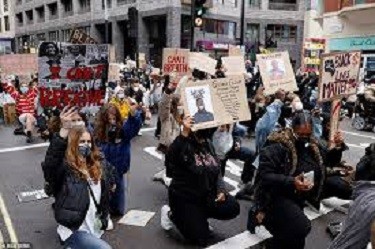By Gabriel Princewill
A poignant one minute silence demonstrated by one knee was objected to by Police Commissioner Cressica Dick, who advised police officers not to participate in the protests in any form or shape.
The Commissioner’s objection was based on rules consistent to social distancing. A largely defiant public, driven by its own agenda to make a statement in unison with others abroad, swarmed Parliament Square in Westminster, protesting the tragic death of the 46-year-old in the US in their thousands.
They comprised a notable concentration of white people in their midst, highlighting a collective spirit of togetherness in their stand for a common purpose. The purpose is for the eradication of racism and discrimination in society.
In a symbolic show of unity, protesters observed a minute’s silence, as hundreds of protesters went down on one knee while raising one fist in the air.
The crowds then began chanting “no justice, no peace” and George Floyd’s name. Majority of demonstrators wore face masks, and others used gloves and hand sanitiser- an indication individual protesters were taking some responsibility for their safety while deciding to protest.
Hundreds of protesters held signs in solidarity with George Floyd, who died in Minneapolis on May 25 after a police officer knelt on his neck for nearly nine minutes as fellow officers played the role of onlookers.
The evil perpetrator of the offence has been charged with second degree murder, and has many years to stare at the unloving walls of a prison cell. His several minutes of monumental indiscretion has become the impetus for multiple protests aimed at highlighting the highest level cold racism can take with some people.
The protests have been deemed unlawful by Home Secretary, Priti Patel, in light of health and safety regulations linked with the present but hopefully abating pandemic.
Congregations like these are reminiscent of recent gatherings at beaches on sunny weekends. except that there appeared to me a higher cognisance of the virus among animated protesters.
Face Masks
Most protesters wore face masks, thereby reducing the risk of spreading or catching the coronavirus.
However, the sheer numbers of protesters assembled in close proximity to one another is not what a government wants to see at a time when it is still struggling to enforce social distancing and gradual restore normality.
Protesters were palpably less concerned; their main objectives geared towards the use of the mass demonstrations to accentuate perceived injustices in the system, and call for appropriate rectification.
Proactive activists will say the protests are mainly symbolic in essence, since the actualisation of any substantive changes or progress will require a strategic framework to assess and conclude on outcomes or implementations.
Colonialism
Some demonstrators went as far as calling for colonialism to be taught in schools. They want children to grow up with an accurate knowledge of history, the presumption being that it would influence their outlook on race.
Exactly how productive such an idea would be has not been openly discussed or appraised.
Radical aspirations of this nature will have to be clear in its overarching aims, and present its structural goals in a way that benefits society altogether, if ever to be considered.
A clearly articulated framework will be imperative, before discussion and multiple debates determines whether such a proposal sees daylight. Chances are that such a proposal wills struggle to ever get off the ground because of its complexities, and the potential ramifications on race relations in the UK.
In the meantime, while the agitation for greater equality of treatment is a worthy call, it must be remembered that Britain remains one of the most loving country to live in, with a higher level of inclusiveness than America and most EU countries.




